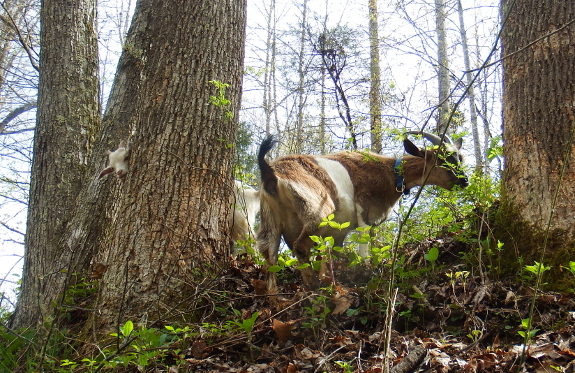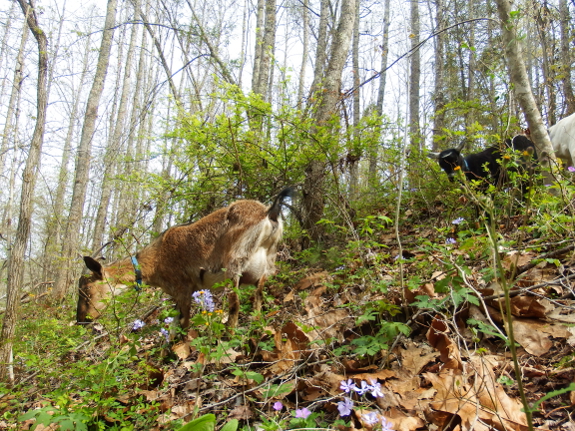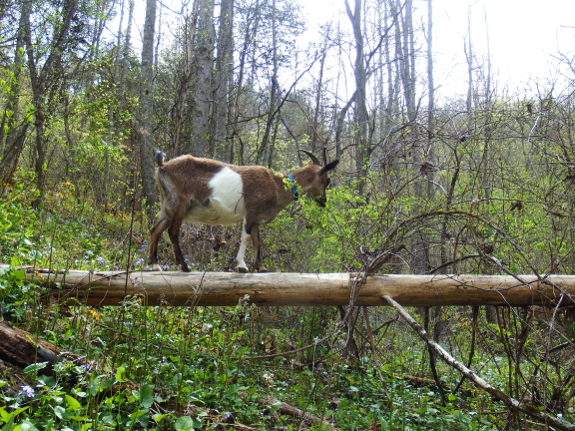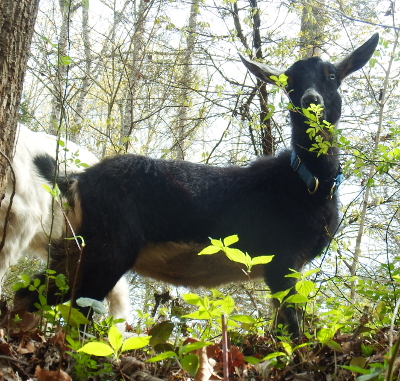
Learning to milk, part two

I've been wanting to
write about my milking adventures for a while, but I never seem to
manage to bring the camera during my morning chores. Plus, it's dim up
in the starplate coop on cloudy mornings (which seems to be most of them
lately), and our milking routine doesn't go as smoothly when a
cameraman is present. So you'll have to settle for these shots of our
little herd grazing in the woods while I write about milking.

As I've mentioned before, I opted to buy an electric milking machine
because my carpal tunnel syndrome can barely handle the amount of
garden weeding I do --- adding milking on top of that sounded like a
recipe for disaster. Of course, it was an added benefit that the milking
machine does the work for me, making it less problematic that I don't
know how to milk a goat.
I say less
problematic, because you really need to know how to milk even if you
own a machine to do the job for you. Never mind the fact that your goat
isn't going to wait for a new machine to come in the mail if the
equipment ever breaks. What's important here and now is that most of the
bacteria in milk are found in the first squirt, which has been sitting
in the teat since the kid took his last sip twelve hours ago. By milking
out and discarding that first squirt by hand, you keep bacterial counts
much lower in the final product.

I'd had one lesson years ago about how to milk a goat and had read books
on the subject, but I'll be honest --- it's taken me about a month to
finally feel proficient with the process. Since I'd read that it's
actually more hygienic not to
wash the udder, I instead massage that area to stimulate milk letdown,
and I've recently begun to be able to tell by feel whether or not
there's any milk in the teat to squirt out. This is what gave me a tough
time at first --- I was trying to squeeze out milk that wasn't there!
Plus, I was being a little too gentle, imagining what it would feel like
if someone squeezed that sensitive part of my anatomy. Watching Lamb
Chop head butt his mother in the udder, though, reminded me that goats
are more rough and tumble than humans, and Abigail responded well to my
firm but gentle touch.
This weekend, I finally got to the point where Abigail and I were
working enough in sync that I was able to leave her head out of the
stanchion, easily discard the first squirts, and then hook up the
machine to harvest the human share. The entire process takes about ten
minutes or less (plus about the same amount of time inside preparing the
goat ration and then washing out the milking lines). As I'd read
elsewhere, milking really isn't the most onerous part of keeping goats
--- I spend much more time tethering them around the yard since we're
always short of fenced pasture.

Six weeks into Abigail's
lactation, we're still only getting about 8 to 10 ounces of milk per
day. This is up a little bit since I started tricking Abigail by milking
out one teat, then the other, then returning to the first for another
round, but Abigail is clearly holding back milk  for
her kid. I'm guessing that Lamb Chop is consuming maybe a quart of milk
per day, although he's finally eating a lot more solid food as well and
should be old enough to wean (if Abigail feels like it) in two more
weeks.
for
her kid. I'm guessing that Lamb Chop is consuming maybe a quart of milk
per day, although he's finally eating a lot more solid food as well and
should be old enough to wean (if Abigail feels like it) in two more
weeks.
So we're not getting much milk yet, but what we are consuming is
absolutely delicious. I can hardly wait until Artemesia (with her
supreme millking genetics) joins the productive portion of our herd. For
now, our little doeling only produces smiles and laughter --- not a bad
harvest from a goat who costs very little to feed.
Want more in-depth information? Browse through our books.
Or explore more posts by date or by subject.
About us: Anna Hess and Mark Hamilton spent over a decade living self-sufficiently in the mountains of Virginia before moving north to start over from scratch in the foothills of Ohio. They've experimented with permaculture, no-till gardening, trailersteading, home-based microbusinesses and much more, writing about their adventures in both blogs and books.
Want to be notified when new comments are posted on this page? Click on the RSS button after you add a comment to subscribe to the comment feed, or simply check the box beside "email replies to me" while writing your comment.

Hi guys,
I saw that you said the goat's milk was delicious. Wow! How does it compare to cow's milk? I've tried goat's milk in the past but thought it tasted like burnt hair. This was from a commercial operation too. Glad you like it but how would you describe it, using cow's milk as the base to compare. Thanks kindly.
diogenese --- We emulated your method without meaning to from the beginning because Abigail didn't want to let her kid nurse and we had to shut her in the stanchion to make it happen. We've been shutting the kid away at night now for about a month, which, interestingly, didn't increase Abigail's extra milk production at all, just made the excess easy to harvest in one fell swoop.
wewally --- We've been giving our goats alfalfa cubes ever since the honeysuckle gave out this winter. But we don't feed grain, which does keep production much lower. We'd rather have healthy goats and healthful milk than higher production though, and Abigail seems to be thriving on her ration of kelp, hay, grass, carrots, alfalfa cubes, and sunflower seeds.
Heather --- Honestly, I've never bought goat milk from the store, so I can't say what's going on with the stuff you tasted. Our goat's milk tastes just like cow's milk but a little sweeter and richer. Of course, the flavor of milk is very dependent on what the goats eat, and I feed a very non-conventional diet (see my note to wewally above), so I wouldn't be surprised if my goat's milk tastes very different from other people's.
Probably true, although human babies aren't always easy on their mothers' nipples either. :^p